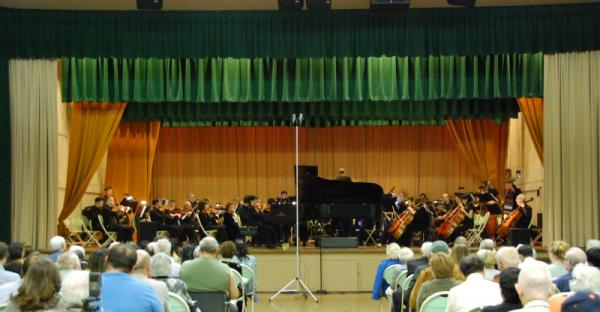I would like to know how to improve the recording I made of my orchestras performance of a piano concerto. The room is difficult to record (all the curtains absorb the sound giving a rather dead sound). Since we have little budget, rather than hiring a recording engineer, I will have to suffice for that position.
My equipment was two Audio-Technica 4047 large-diaphragm cardioid condenser mics with a Shure s15A telescoping stand, and a Tascam DR-100 field recorder with XLR cables.
Please download the sample recording here:
https://download.yousendit.com/RmNBUGhVdkd6RTljR0E9PQ
This is a large download (about 48 megs).
I included a small picture to show mic placement. The microphones were in an X/Y configuration about 5 feet from the stage and about 13 feet above the floor. The mics were facing slightly down and focused on the rear of the cello/viola section and the rear of the second violins. The piano was about 2 feet from edge of the stage so I would guess the mic was 6-7 feet in front of the piano.
The winds and trumpets are almost completely lost (they were directly in front of the mics). Since in an X/Y pattern, neither mic is facing them, I thought they would still be caught by the overlap of the X/Y pattern produced from both mics. Also, the timpani is very soft compared to the snare drum though they were right next to each other. I also find the stereo spread very mono sounding - I thought that X/Y was known for wide stereo spread? How can I get better results?
Thanks.
Comments
Thanks for the feedback. I appreciate it. Perhaps it isn't as
Thanks for the feedback. I appreciate it. Perhaps it isn't as bad off as I first thought. The GMulti helped and some EQing of the low end helped with the muddiness. I think the problem I now have is the center of the stereo field is missing - the winds and trumpets which were directly in front of the mics are really low. I don't know if there is anything I can do with my mic setup to boost that and retain a stereo image. Such is the lot of low budget recording.
You can't fix what didn't print to the track. Next time if you
You can't fix what didn't print to the track. Next time if you had an identical setup using XY your would want to angle slightly in towards the center so the XY was not strictly 90 degrees. This is the "art" part of the job. Knowing your mic's and your techniques and the ensemble well enough to adjust from the textbook. Keep at it. Don't monkey with trying to find missing parts.
kazam, post: 344780 wrote: Thanks for the feedback. I appreciat
kazam, post: 344780 wrote: Thanks for the feedback. I appreciate it. Perhaps it isn't as bad off as I first thought. The GMulti helped and some EQing of the low end helped with the muddiness. I think the problem I now have is the center of the stereo field is missing - the winds and trumpets which were directly in front of the mics are really low. I don't know if there is anything I can do with my mic setup to boost that and retain a stereo image. Such is the lot of low budget recording.
For the future, there are several paths you could take. Follow Jack's advice for your X-Y pair, or spread them even wider and fit a third microphone in the centre, like a Decca Tree.
For the "hole-in-the-middle" recording you have just made, you could try using the M-S encode/decode features of your DAW. Encode the L-R tracks to M-S, boost the M level by (say) 3dB and reduce the S level by the same amount. Decode the result back to L-R. Set it up so you can listen to the result in real time, adjusting the M and S levels to achieve a better coverage of the centre sounds.




This really isn't that bad. You can do one of a couple things t
This really isn't that bad. You can do one of a couple things to "widen" the stereo image. Use a plugin like GVST's GMulti which is free. Alternatively you can break the stereo track apart in a DAW into the individual left and right channels and play with the pan there. As to the trumpets, I heard them. I also heard the bones which are also directional without issue. I heard the horns which if anyone is going to be buried in that setup it's them. Basically if you want more trumpet then they have to step up and grow a pair but I thought they were uncharacteristically (for trumpets that is) balanced with the other brass. The piano was a little hot but you had little choice with the mic positioning if you were going to include the piano.
Now, for the XY itself, you would have been better off to hang one of the mic's upside down on top of the other one and then rotated at 90 degrees to each other. Also, you could easily have used ORTF but you would have needed your protractor and a tape to get the positioning. XY is just the easiest technique though still perfectly valid and usable.